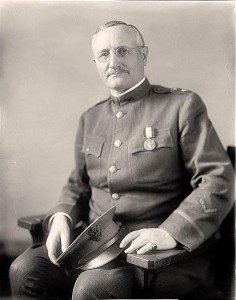
William L. Sibert
When I was wrestling six years ago with a path through what became my book Water Is For Fighting Over, I collected material about what I came to call “the great mistake” – the overallocation of the Colorado River’s water. One of my favorite stories surrounded William Sibert:
It is quite probable that the compact attempts to apportion more water than the actual average undepleted flow of the river.
That’s circa 1928, before Congress ratified the Colorado River Compact and approved the construction of Hoover Dam, in a technical review of the project requested by Congress.
I set the topic aside back in 2013 in part because of the technical complexity of the early water math. I frankly had a hard time with the analytical framework (which period of record? which gauges? what upstream depletions? and on….), and the task of writing sensibly about something I couldn’t fully grasp myself was daunting.
Thanks to Eric Kuhn, who’d been thinking along the same lines and who had the analytical chops to make sense of what Sibert and others at the time were saying, we’ve had a chance to take another crack at “the great mistake”.
There in the pages of the Sibert board’s report was a clear message. The nineteenth-century droughts … meant the Colorado River had less water than the boosters had imagined when they crafted the 1922 Colorado River Compact and the federal legislation now before the Congress to ratify the compact and launch construction of what would become the Hoover Dam. The report’s math was inescapable. Once reservoir evaporation and water for Mexico were taken into consideration, any realistic effort to estimate the river’s flow left too little water to meet the allocations carved out in the 1922 compact and about to be ratified by Congress in federal statute.
That’s from “The Sibert Report: A Lost Opportunity”, Chapter 6 of our new book Science Be Dammed: How Ignoring Inconvenient Science Drained the Colorado River, out next month from the University of Arizona Press.
Sibert’s story is an important one that has been largely lost to history, relegated to footnotes or ignored entirely. A retired Army officer and engineer, he headed a panel chartered by Congress in 1928 to review the feasibility of the project about to be launched:
A board of engineers would be tasked with advising federal decision-makers on “matter affecting the safety, the economic and engineering feasibility, and adequacy of the proposed structure and incidental works” to be built on the Colorado River.
Critics of what would become Hoover Dam hoped to scuttle it on technical grounds – could they really build a dam that big? But Sibert, to his credit, took his charge of “economic feasibility” seriously. Would there be enough water to generate the electricity to pay for the project? That required him to take up the underlying question – does the Colorado River really have enough water to honor the allocations in the legislation Congress was about to approve?
His answer, quoted above, was “no”.
Water nerds in the audience will love Eric’s dissection of Sibert’s analysis of the river’s flows. (Buy our book!) More importantly, I hope water nerds in the audience will I hope appreciate Sibert’s probabilistic approach to water management:
Rather than picking one number, the board suggested the planning consider a range, with flows available for future depletion ranging from 10 million acre-feet during drought periods as long as 15–20 years, to high flows over similar time periods of 14.5 million acre-feet, with a long-term average somewhere in the middle.
As we explain in the book, there was too much momentum in Congress and the nation, and Sibert’s careful analysis was ignored. We live today with the consequences.

The water industry today still is too pre-occupied with “averages”. Mother nature confronts us with daily volatility. If the “Graduate” were remade today, the key words would be “risk management.” Sibert’s analysis is spot on.
John – I am probably wrong, but wasn’t the Compact approved in 1922 and Hoover Dam authorized in 1928?
Michael –
1928 was really the critical go-no go year for this.
The Compact was negotiated and signed in 1922, but there were a bunch of subsequent steps. The Compact required ratification by each state and Congress. Most of the states ratified quickly (1923) but Arizona did not.
The action then moved to Congress, where the back and forth dragged on for years. (Some of the key science we talk about in the book shows up there, during this time period.)
The Boulder Canyon Project Act, approved by Congress in December 1928 and signed the the following January, finally provided the necessary federal ratification, tweaked it to permit a six-state ratification (absent Arizona) and authorized Hoover Dam. The non-Arizona states then had to ratify the six-state version, which didn’t happen until 1929. The 1928 debates were pretty intense, actually, and really mark the decision point to go ahead with the river’s development. That’s why Sibert’s role at this crucial moment was so important.
Hey John – now that you laid it out, I remember the long subsequent negotiations. I was stuck on ‘28 for the dam. Thanks